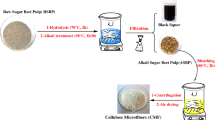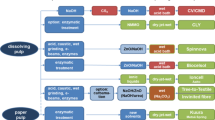Abstract
Hemp (émph{Cannabis Sativ L}.) is an important lignocellulosic raw material for the manufacture of cost-effective environmentally friendly composite materials. From an earlier experiment it was found that when hemp bast fibers were heated between 160∘C and 260∘C, there was softening of lignin leading to opening of fibers and the preliminary observations showed that heat treatment at 220∘C in an inert environment seemed to provide enough fiber without affecting the associated tissues of the fibers. However, these heat treated fibers need to be separated by mechanical action. For this experiment, hemp fibers were given heat treatment in an enclosed vessel in a nitrogen environment at 220∘C for 30 min and then they were ball milled. It was found that there was further opening of fibers upon ball milling of the heated fibers and the total number of fibers increased for the equal weight of fibers. It was not possible to find strength properties of shorter length fibers; however, the results from shorter clamping length indirectly indicated that these fibers were of higher strength. The ball milled fibers also contained copious amount of fines which must be removed before using the fibers for composite manufacturing.
Similar content being viewed by others
References
P. R. HORNSBY, E. HINRICHSEN and K. TARVERDI, J. Mater. Sci. 32 (1997) 443.
A. STAMBOULIS, C. A. BAILLIE, S. K. GARKHIL, H. G. H. VAN MELICK and T. PEJIS, Appl. Comp. Mat. 7 (2000) 273.
A. G. MCDONALD, A. B. CLARE and B. DAWSON, In Proc 53rd General APPITA Conf. Rotorua, (New Zealand, 1999) p. 51.
G. STROM and G. CARLSSON, J Adhesion Sci & Technol. 6 (1992) 745.
B. J. LEE, A. G. MCDONALD and B. JAMES, Mat Res Innovat 4 (2001) 97.
D. N. SAHEB and J. P. JOG, Advances in Polymer Technology 18 (1999) 351.
W. L. MCCABE, J. C SMITH and P. HARRIOT, in “Unit Operations of Chemical Engineering” (McGraw-Hill Inc., New York, 1993), p. 960.
R. H. PERRY and D. W. GREEN PERRY, in “Perry’s Chemical Engineers’ Handbook”, (McGraw-Hill, 1984).
B. M. PRASAD, M. M. SAIN and D.N. ROY, Macromol. Mater. and Eng. 289 (2004) 581.
F. CORREIA, D. N. ROY and K. GOEL, J. Wood Chem. Techn. 21 (2001) 97.
J. E. ATCHISON and J. N. MCGOVERN, Pulp and paper manufacture, Vol. 3 Secondary fibers and non-wood pulping published by joint textbook committee of the paper industry.
N. YAN and M. T. KORTSCHOT, Single Fiber Pull-out Tests and the Elmendorf Tear Strength of Paper. 83rd Annual Meeting, Technical Section CPPA (1996), pp. A179–A183.
C. BALEY, Composites: Part A 33 (2002) 939–948.
B. M. PRASAD and M. M. SAIN, Mat. Res. Innovat. 7 (2003) 231.
Author information
Authors and Affiliations
Corresponding author
Rights and permissions
About this article
Cite this article
Prasad, B.M., Sain, M.M. & Roy, D.N. Properties of ball milled thermally treated hemp fibers in an inert atmosphere for potential composite reinforcement. J Mater Sci 40, 4271–4278 (2005). https://doi.org/10.1007/s10853-005-2799-5
Received:
Accepted:
Issue Date:
DOI: https://doi.org/10.1007/s10853-005-2799-5




